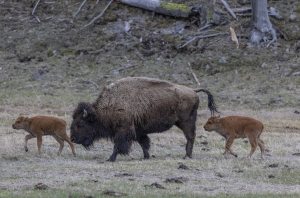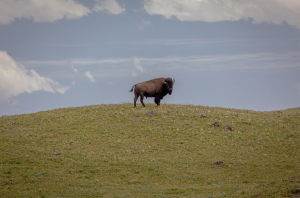Following the celebration of America’s independence, the timing for the release of the National Park Service’s (NPS) plan to manage the biggest wild population of our national animal – the American bison – could not have been more appropriate. The long-anticipated Final Environmental Impact Statement (FEIS) provides updates to the nearly 25-year-old Yellowstone National Park Bison Management Plan and, in doing so, became a symbol of the intricate relationships between Tribal, state, and federal wildlife management agencies.
After much debate and tremendous public input, the plan adopts a more respectful tone toward bison and creates the opportunity to further examine our national relationship with this keystone species and cultural totem for many Native peoples.
By the numbers, the NPS ultimately chose an alternative that allows for Yellowstone bison, comprised of northern and western herds, to be managed for a combined population of 3,500-6,000 (post-calving) — roughly similar to averages in recent years. There will be a population “assurance threshold” of 5,200 animals in early winter, ensuring adequate calf recruitment. In years that bison populations exceed targets, the plan calls for more robust use of the Bison Conservation Transfer Program, prioritizing actions that enter animals into a quarantine program (for brucellosis risk management) for eventual release onto Tribal lands instead of being shipped out for slaughter – mostly for Tribal and other meals programs. Tribal and public hunts also serve to manage animals that range into two concentric “tolerance zones” that extend beyond YNP boundaries.

Appeals to the NPS in public Draft EIS comments, including those from ICL, encouraged the agency to manage bison more like other native ungulates, allowing for animals to naturally migrate from the Park, into and around the Greater Yellowstone Ecosystem. However, while recent research shows that transfer of brucellosis to cattle comes from wild elk (NOT BISON!), the new plan, unfortunately, maintains fairly strict sideboards on how far bison are allowed to range onto public lands adjacent to YNP and potentially interact with commercial livestock operations.
This is certainly due to continued legal threats from the State of Montana. Despite being scientifically disproven, concerns from the ranching industry about brucellosis disease transfer from bison to cattle are still quite pervasive. Recent and consequential findings on brucellosis implications of bison-elk-cattle interactions, in part, gave rise to efforts to revise the previous bison plan.
It’s also noteworthy that the NPS showcased the latest brucellosis research in creating an entire appendix to the FEIS, citing findings from the National Academies of Sciences, Engineering, and Medicine. Among the many recommendations made in their 2020 paper, the scientific body guided that, “until tools become available that would simultaneously allow for an eradication program (of brucellosis) in elk, additional aggressive control measures in bison seem unwarranted.”
Accordingly, despite Montana’s objections, the plan does allow, in some cases, for bison to migrate “into designated management areas in Montana, including portions of the Custer Gallatin National Forest that would support conservation and increase tribal harvest opportunities.”

More than 50 million acres of tallgrass, mixed/short grass prairies and sagebrush shrub-steppe landscapes have been lost in just the past decade due to invasive plants, large-scale fire, agricultural conversion and development. As highly mobile “ecosystem engineers,” American bison sit atop this biologically, culturally, and economically invaluable grassland landscape and can be a critical lever to help restore it. Bison can help our public lands retain more moisture and assist in increasing biodiversity of avian, mammalian, and amphibian species. As a highly-adapted native grazer, they are also well-suited to tolerate changing environmental conditions expected to come from climate change.
Due to the important ecosystem benefits that come from having wild, free-ranging bison, ICL will closely follow how bison are allowed to occupy sections of public land adjacent to Yellowstone. There’s ample evidence that, well into the 1830s, bison roamed large sections of the Rockies far beyond what is now defined by Park boundaries. James Bailey’s American Plains Bison: Rewilding an Icon offers historic accounts by western trappers like Osborne Russell that put thousands of bison in intermountain valleys, alpine grasslands and forests between the Lewis and Clark route and places like Henry’s Lake, Duboise, Fort Hall and other parts of southeast Idaho. We believe true progress will be made in Yellowstone bison management when the NPS and surrounding states can deliver on this indispensable language in the new plan to “work with partners to explore other management options outside the park, including…more bison year-round on the Custer Gallatin National Forest per the 2022 Land Management Plan (LMP).”
While not a massive evolutionary leap from current management approaches, the NPS deserves credit for this significant undertaking in the face of heated political pressure. This FEIS and the forthcoming Record of Decision (due mid-July) could serve as a springboard for our region to have more substantive conversations about allowing bison to re-occupy historically significant landscapes in the Greater Yellowstone Ecosystem. ICL looks forward to being part of that profound conservation undertaking and celebrates the spirit of the new Yellowstone National Park Bison Management Plan.
Stay updated on ICL’s work on bison and other wildlife by signing up for our Wildlife Campaign email updates.
